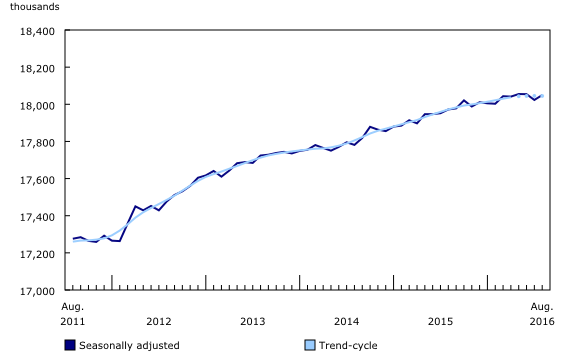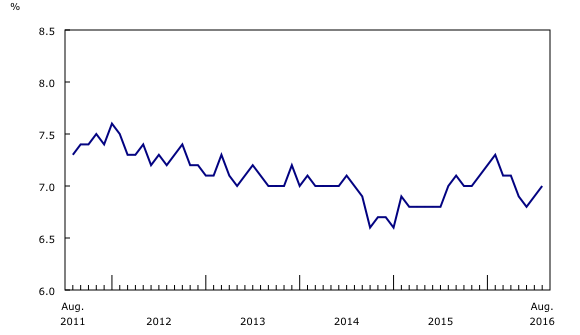Labour Force Survey, August 2016
Archived Content
Information identified as archived is provided for reference, research or recordkeeping purposes. It is not subject to the Government of Canada Web Standards and has not been altered or updated since it was archived. Please "contact us" to request a format other than those available.
Released: 2016-09-09
Following a decline in July, employment edged up in August (+26,000 or +0.1%). The unemployment rate rose 0.1 percentage points to 7.0%, as more people participated in the labour market.
Compared with 12 months earlier, employment increased by 77,000 (+0.4%), with all of the gains in part-time work. Over the same period, the total number of hours worked fell slightly (-0.4%).
In August, employment increased among youths aged 15 to 24 and people aged 55 and older. At the same time, employment was down among those aged 25 to 54.
Employment rose in Quebec and in Newfoundland and Labrador, while it declined in New Brunswick. There was little change in the other provinces.
There were more people working in public administration and fewer people working in professional, scientific and technical services.
Public sector employment increased in August, while self-employment fell and the number of private sector employees was little changed.
Employment up for youths and people 55 and older
In August, employment increased by 22,000 among youths aged 15 to 24. However, the unemployment rate was little changed at 13.2%, as more youths participated in the labour market. On a year-over-year basis, employment for this group was down 48,000 (-1.9%), and their population was also down by 48,000 (-1.1%).
For people aged 55 and older, employment rose by 29,000 in August with increases among both men and women. The unemployment rate was unchanged at 6.0%, as more people in this age group participated in the labour market. Compared with 12 months earlier, employment among people aged 55 and older was up by 133,000 (+3.7%), and their population increased by 315,000 (+3.1%).
Employment among people aged 25 to 54 decreased by 25,000 in August. Among men, employment edged down, and their unemployment rate increased 0.3 percentage points to 6.6%. For women, employment was little changed, and their unemployment rate was 5.2%. On a year-over-year basis, employment for people aged 25 to 54 was virtually unchanged and their population increased by 51,000 (+0.3%).
Provincial summary
In Quebec, employment rose by 22,000 in August, and the unemployment rate was little changed at 7.1%, as more people participated in the labour market. Compared with 12 months earlier, employment in the province was up 34,000 (+0.8%).
In Newfoundland and Labrador, employment increased by 4,000 in August, and the unemployment rate edged down to 12.3%. Despite the increase in August, there was little employment change on a year-over-year basis.
Employment in New Brunswick declined by 3,000 in August, and the unemployment rate was 9.4%. Compared with 12 months earlier, employment in New Brunswick was essentially unchanged.
Employment in Ontario was little changed on both a monthly and year-over-year basis. However, in August, the unemployment rate increased 0.3 percentage points to 6.7%, as more people searched for work.
In British Columbia, employment was virtually unchanged in August. The unemployment rate was also little changed at 5.5% and remained the lowest among the provinces. On a year-over-year basis, employment in British Columbia increased by 73,000 or 3.1%, the highest growth rate among the provinces.
Industry perspective
In August, employment in public administration increased by 16,000. Despite an overall increase, there were employment declines among survey interviewers and statistical clerks, an occupational group that corresponds with activities related to the 2016 Census. Compared with 12 months earlier, employment in public administration was virtually unchanged.
Employment declined by 23,000 in professional, scientific and technical services. Employment in this industry was little changed on a year-over-year basis.
Public sector employment increased by 57,000 in August, offsetting declines observed in July. Compared with 12 months earlier, public sector employment was virtually unchanged. The public sector includes all employees in public administration, most employees in utilities, and some employees in education, health care and social assistance, transportation and warehousing, and other industries.
Self-employment fell by 39,000 in August and was little changed on a year-over-year basis.
The number of employees in the private sector was little changed compared with the previous month, while it increased by 97,000 (+0.8%) compared with 12 months earlier.
Summer employment for students
From May to August, the Labour Force Survey collects labour market data about youths aged 15 to 24 who attended school full time in March, and who intend to return full time in the fall. Published data are not seasonally adjusted; therefore, comparisons can only be made on a year-over-year basis.
For students aged 15 to 24, the average employment rate for the summer (that is, from May to August) was 48.8%, similar to the rate of 49.1% observed in 2015.
The average employment rate for students aged 20 to 24 was 64.9% in the summer of 2016 (compared with 66.0% in 2015); for students 17 to 19 it was 55.1% (compared with 54.5%); and for those aged 15 and 16 it was 24.7% (compared with 25.2%).
The average unemployment rate over the summer for students aged 20 to 24 was 10.2%, virtually unchanged from the rate of 10.1% observed for 2015. At the same time, the unemployment rate was 15.3% for those aged 17 to 19 (compared with 17.3% in 2015), and 28.1% for those aged 15 and 16 (compared with 29.7%).
Canada–United States comparison
Adjusted to the concepts used in the United States, the unemployment rate in Canada was 5.9% in August compared with 4.9% in the United States. On a year-over-year basis, the unemployment rate was essentially unchanged in Canada, while it declined slightly in the United States (-0.2 percentage points).
The labour force participation rate in Canada (adjusted to US concepts) was 65.4% in August, compared with 62.8% in the United States. The participation rate in Canada declined 0.4 percentage points over the past 12 months, while it increased slightly in the United States (+0.2 percentage points).
In August, the US-adjusted employment rate in Canada stood at 61.5% compared with 59.7% in the United States. On a year-over-year basis, the employment rate declined by 0.4 percentage points in Canada while it increased by 0.3 percentage points in the United States.
For further information on Canada–US comparisons, see "Measuring Employment and Unemployment in Canada and the United States – A comparison."
Note to readers
Collection resumes in Fort McMurray
As a result of the wildfire affecting northern Alberta, Labour Force Survey (LFS) data for the census agglomeration of Wood Buffalo, which includes Fort McMurray, were not collected from May to July 2016. Collection resumed in Wood Buffalo with the August LFS and data for this area are reflected in the national and Alberta estimates published this month. Separate estimates for the economic region of Wood Buffalo–Cold Lake, which are published as three-month moving averages, are not available for June, July or August 2016.
The LFS estimates for August are for the week of August 14 to 20.
The LFS estimates are based on a sample and are therefore subject to sampling variability. As a result, monthly estimates will show more variability than trends observed over longer time periods. For more information, see "Interpreting Monthly Changes in Employment from the Labour Force Survey". Estimates for smaller geographic areas or industries also have more variability. For an explanation of sampling variability of estimates and how to use standard errors to assess this variability, consult the "Data quality" section of the publication Labour Force Information (71-001-X).
This analysis focuses on differences between estimates that are statistically significant at the 68% confidence level.
The LFS estimates are the first in a series of labour market indicators released by Statistics Canada, which includes indicators from programs such as the Survey of Payroll Employment, Earnings and Hours (SEPH), Employment Insurance Statistics, and the Job Vacancy and Wage Survey. For more information on the conceptual differences between employment measures from the LFS and SEPH, refer to section 8 of the Guide to the Labour Force Survey (71-543-G).
The employment rate is the number of employed people as a percentage of the population aged 15 and older. The rate for a particular group (for example, youths aged 15 to 24) is the number employed in that group as a percentage of the population for that group.
The unemployment rate is the number of unemployed as a percentage of the labour force (employed and unemployed).
The participation rate is the number of employed and unemployed as a percentage of the population.
Seasonal adjustment
Unless otherwise stated, this release presents seasonally adjusted estimates, which facilitates comparisons by removing the effects of seasonal variations. For more information on seasonal adjustment, see Seasonally adjusted data – Frequently asked questions.
Chart 1 shows trend-cycle data on employment. These data represent a smoothed version of the seasonally adjusted time series, which provides information on longer-term movements, including changes in direction underlying the series. These data are available in CANSIM table 282-0087 for the national level employment series. For more information, see the StatCan Blog and Trend-cycle estimates – Frequently asked questions.
Next release
The next release of the LFS will be on October 7.
Products
A more detailed summary, Labour Force Information (71-001-X), is now available for the week ending August 20. From the Browse by key resource module of our website under Publications, choose All subjects, then Labour.
More information about the concepts and use of the Labour Force Survey is available online in the Guide to the Labour Force Survey (71-543-G), from the Browse by key resource module of our website, under Publications.
Contact information
For more information, contact us (toll-free 1-800-263-1136; 514-283-8300; STATCAN.infostats-infostats.STATCAN@canada.ca).
To enquire about the concepts, methods or data quality of this release, contact Andrew Fields (613-951-3551; andrew.fields@canada.ca), or Vincent Ferrao (613-951-4750; vincent.ferrao@canada.ca), Labour Statistics Division.
- Date modified:





